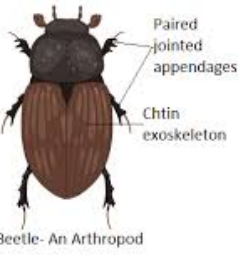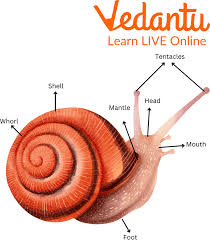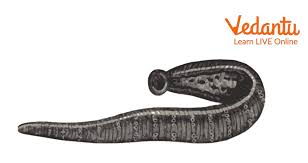What Are Invertebrates? Classification, Key Traits, and Examples
Invertebrates are animals that do not have a backbone (vertebral column). They make up the vast majority of the animal kingdom, accounting for around 97% of all known animal species. From tiny insects in your garden to large squids in the ocean, invertebrates can live in diverse habitats including deserts, rainforests, polar regions, and deep oceans.
Scientists study Invertebrates to understand essential life processes, ecological interactions, and evolutionary patterns. They play many important roles, such as pollinating plants, breaking down organic matter, and serving as a vital part of food chains. This page will help you learn about the different types of these invertebrates animals, their unique features, and their broader importance in nature.
Types of Invertebrates
There are several ways to group invertebrates. A common approach is to group them by habitat:
Land-dwelling: Insects, spiders, worms, millipedes, centipedes, and others
Freshwater: Water fleas, water snails, freshwater sponges, crayfish, and some worms
Marine: Corals, sea stars, sea urchins, jellyfish, crustaceans, and many more
One widely used invertebrates classification recognises 8 groups of invertebrates (major phyla) as follows:
Porifera (Sponges)
Cnidaria (Coelenterata)
Platyhelminthes (Flatworms)
Nematoda (Roundworms)
Annelida (Segmented worms)
Phylum Arthropods (Insects, spiders, crustaceans, etc.)
Phylum Mollusca (Snails, octopuses, clams, etc.)
Echinodermata (Sea stars, sea urchins, etc.)
In everyday learning, many students focus on four major groups: arthropods, molluscs, annelids, and coelenterates. Let us look at the characteristics of invertebrates, followed by these groups in detail.
Characteristics of Invertebrates
Although invertebrates are a very diverse group, they generally share a few key traits:
No Backbone: They lack a vertebral column (backbone). Some have hard outer coverings (exoskeletons) or shells for protection and structure.
Size: Many invertebrates animals are small, but there are exceptions, such as giant squids.
Respiration: Most do not have lungs. They often breathe through their skin, through specialised structures like gills, or using breathing tubes (tracheae in insects).
Heterotrophic: Like all animals, invertebrates cannot produce their own food, so they depend on other organisms for nutrition.
Reproduction: Many reproduce sexually, but some can also reproduce asexually (e.g., budding or fission in simple organisms like hydra and some worms).
Phylum Arthropods
Phylum Arthropods is the largest and most diverse group of invertebrates. Arthropods have:
A segmented body (divided into head, thorax, and abdomen or cephalothorax and abdomen in some groups)
Jointed legs
A strong exoskeleton made mostly of chitin

They live in almost every environment: land, air, freshwater, and oceans. Examples include insects (such as bees and beetles), spiders, scorpions, crustaceans like crabs and lobsters, and centipedes. Their exoskeleton protects them, but they must shed (moult) it to grow.
Phylum Mollusca
Phylum Mollusca includes animals with soft bodies. Most molluscs have a mantle, a special fold of tissue that can secrete a shell. Major features include:
Unsegmented bodies
A muscular foot used for movement or for attaching to surfaces
Presence of a mantle that may or may not form an external shell

Common examples are snails, octopuses, squids, clams, and oysters. Many molluscs live in the sea or in freshwater, but some (like snails and slugs) are found on land. The colossal squid is one of the largest invertebrates animals known, with only a few specimens ever discovered.
Phylum Annelida
Phylum Annelida comprises segmented worms that include earthworms, leeches, and marine worms. Important traits are:
Body segmentation that repeats along the length of the animal
A body wall made up of ring-like segments
Well-developed organ systems

Earthworms are a classic example. They are often considered helpful to humans because they improve soil quality by aerating it and turning organic matter into nutrient-rich compost. The giant Amazon leech is among the largest of these invertebrates animals.
Phylum Coelenterata
Phylum Coelenterata (also called Cnidaria) generally refers to radially symmetrical animals with two body layers:
Ectoderm (outer layer)
Endoderm (inner layer)
They typically have tentacles bearing stinging cells (nematocysts) for capturing prey and for defence. Examples include jellyfish, corals, sea anemones, and hydra. Corals form reefs that host some of the most diverse ecosystems on Earth.
Other Major Invertebrate Groups
While the four phyla above often receive the most attention, there are many other important groups worth knowing about:
Porifera (Sponges): Simplest animals without tissues or organs. They filter feed by pumping water through pores.
Platyhelminthes (Flatworms): Flattened bodies; includes tapeworms and planarians.
Nematoda (Roundworms): Cylindrical worms that often live as parasites or free-living organisms in soil and water.
Echinoderms: Starfish, sea urchins, and brittle stars with spiny skins and unique water vascular systems.
These groups all fit into the broader invertebrates classification and show how diverse and adaptable invertebrates can be.
Unique Add-Ons: Quiz and Mnemonic
Quick Quiz (with Answers)
Which phylum includes animals with jointed legs and an exoskeleton?
Answer: Arthropods
Which invertebrate group typically has a mantle that secretes a shell?
Answer: Mollusca
Name the phylum for segmented worms like earthworms.
Answer: Annelida
Which phylum includes jellyfish and corals?
Answer: Coelenterata (Cnidaria)
What is the main feature that distinguishes invertebrates animals from vertebrates?
Answer: The absence of a backbone (vertebral column)
Simple Mnemonic for 8 Major Invertebrate Groups
You can use the mnemonic “Please Come Play Now And Ask Many Eels” to remember:
P = Porifera
C = Cnidaria (Coelenterata)
P = Platyhelminthes
N = Nematoda
A = Annelida
A = Arthropods
M = Mollusca
E = Echinoderms
Related Topics


FAQs on Invertebrates: Types, Classification, and Essential Features
1. What are the essential features that define an animal as an invertebrate?
An invertebrate is primarily defined by the absence of a backbone or vertebral column. Other essential features include being multicellular, eukaryotic, and heterotrophic (meaning they cannot produce their own food). Their body plans show immense variety, ranging from simple structures to highly complex organisms.
2. What is the basis for classifying the diverse groups of invertebrates?
The classification of invertebrates is based on several key morphological and developmental characteristics. These criteria help biologists group them into different phyla. The main bases for classification include:
- Levels of Organisation: Whether the cells are arranged as a loose aggregate (cellular level), in tissues (tissue level), or in organs (organ system level).
- Body Symmetry: Whether the body can be divided into equal halves. It can be asymmetrical (sponges), radially symmetrical (jellyfish), or bilaterally symmetrical (insects, worms).
- Coelom (Body Cavity): The presence or absence of a body cavity between the body wall and the gut wall. This leads to acoelomates, pseudocoelomates, and coelomates.
- Segmentation: The division of the body into a series of repeated segments, a feature prominent in annelids and arthropods.
3. What are the major phyla of invertebrates, with examples?
The animal kingdom includes over 30 invertebrate phyla. The most significant ones as per the NCERT syllabus are:
- Phylum Porifera: Simple, pore-bearing animals. Example: Sponges.
- Phylum Cnidaria: Radially symmetrical animals with stinging cells. Examples: Jellyfish, Hydra, Corals.
- Phylum Platyhelminthes: Dorso-ventrally flattened worms. Examples: Tapeworm, Planaria.
- Phylum Annelida: Segmented worms. Examples: Earthworm, Leech.
- Phylum Arthropoda: The largest phylum, with jointed legs and a chitinous exoskeleton. Examples: Insects, Spiders, Crabs.
- Phylum Mollusca: Soft-bodied animals, often with a shell. Examples: Snail, Octopus, Oyster.
- Phylum Echinodermata: Spiny-skinned marine animals with radial symmetry in adults. Examples: Starfish, Sea Urchin.
4. How do invertebrates breathe without having lungs?
Invertebrates have evolved a variety of respiratory mechanisms to suit their environments. Simple organisms like sponges and jellyfish breathe through direct diffusion of gases across their body surface. Aquatic invertebrates like crabs and some molluscs use gills. Terrestrial insects have a specialised network of tubes called the tracheal system that delivers oxygen directly to their tissues, while spiders use structures known as book lungs.
5. What is the importance of invertebrates in our ecosystem?
Invertebrates play a critical role in maintaining ecological balance. Their importance includes:
- Pollination: Insects like bees and butterflies are essential for pollinating a vast majority of flowering plants, including many food crops.
- Decomposition: Organisms like earthworms and millipedes are decomposers that break down dead organic matter, recycling nutrients back into the soil.
- Food Web: They form a crucial link in the food web, serving as a primary food source for many birds, fish, and mammals.
- Pest Control: Many invertebrates, such as spiders and ladybugs, are natural predators that help control populations of agricultural pests.
6. Why are invertebrates considered so biologically successful and diverse?
The immense success and diversity of invertebrates can be attributed to their long evolutionary history and ability to adapt. They were the first animals to evolve and have had hundreds of millions of years to colonise nearly every habitat on Earth. Key factors include their small body size, which allows them to exploit a wide range of niches, and their varied reproductive strategies, including rapid asexual reproduction, which allows their populations to grow quickly.
7. What is the key difference between an exoskeleton and an endoskeleton?
The key difference lies in their location and composition. An exoskeleton, found in arthropods like insects and crabs, is a hard, non-living external covering made of chitin. It provides excellent protection but must be shed (a process called moulting) for the animal to grow. In contrast, an endoskeleton, found in echinoderms and all vertebrates, is an internal framework of living tissue (like bone or cartilage) that grows along with the animal.
8. Are insects the only type of arthropod?
No, insects are just one class within the phylum Arthropoda. While they are the most numerous group, Arthropoda also includes other major classes such as:
- Arachnida: Which includes spiders, scorpions, ticks, and mites.
- Crustacea: Primarily aquatic animals like crabs, lobsters, shrimps, and barnacles.
- Myriapoda: Which includes centipedes and millipedes.
All these groups share the defining arthropod features of a hard exoskeleton and jointed appendages.
9. Do all invertebrates have a simple nervous system?
No, this is a common misconception. The complexity of the nervous system varies greatly among invertebrates. While simple animals like Hydra have a basic nerve net, more advanced groups show significant cephalisation (formation of a head). For example, annelids and arthropods have a more centralised nervous system with a brain and a ventral nerve cord. The most complex invertebrate nervous system belongs to cephalopods like the octopus, which has a large, highly developed brain capable of complex problem-solving and learning.










